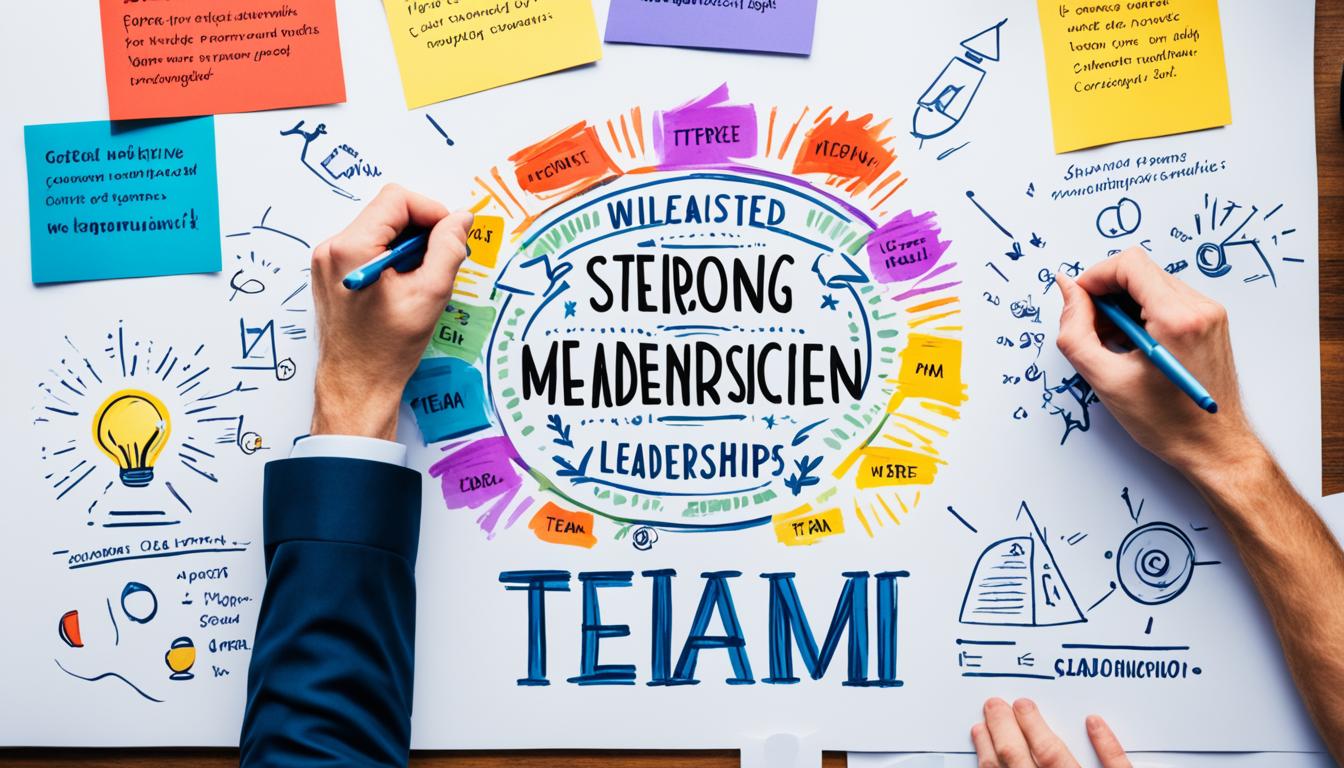Looking back on my leadership journey, I’ve seen how our mindset deeply affects our actions and our team’s success. A key moment made me realize my fixed thinking was stopping my team from reaching their full potential. This realization changed how I lead others.
Over a decade of research across various organizations has shown the huge effect of leadership mindset on team performance. This study looked at hundreds of leaders and found that our mental models greatly affect our effectiveness. They also impact our teams’ success. The way we think about leadership changes how we interact, make decisions, and help our teams grow.
Leadership styles vary, each leaving its mark on team dynamics. For example, autocratic leaders often give emotionally charged feedback. On the other hand, bureaucratic leaders use metrics a lot. These styles can greatly change how team members see their value and role.
The best leaders have an integrator mindset. They focus on trust and always improving. They see feedback as a way to grow, not just judge. This creates a culture where both positive and constructive feedback are key to improving team performance.
Key Takeaways
- Leadership mindset greatly affects team performance and success
- Research over 10 years shows personal experiences shape leadership effectiveness
- Different leadership styles (autocratic, bureaucratic, democratic, integrator) uniquely impact team dynamics
- Integrator mindset focuses on trust and continuous improvement
- Effective leaders balance positive and constructive feedback for team growth
- Continuous performance management enhances leadership and team development
Understanding Leadership Mindset and Its Significance
Leadership mindset shapes how leaders think and act. It’s key for good communication, motivation, and solving conflicts. A leader’s mindset greatly affects a team’s success.
Defining Leadership Mindset
Leadership mindset is about beliefs and attitudes that guide a leader. It shapes how they tackle challenges and make decisions. A growth mindset sees problems as chances to learn and grow.

The Role of Mindset in Shaping Leadership Behaviors
A leader’s mindset affects their actions and choices. A positive mindset makes meeting goals 25% more likely. It builds resilience, boosts innovation, and supports learning in the team.
How Mindset Influences Organizational Culture
Leadership mindset shapes the company culture. Leaders with a growth mindset create a culture that values learning and challenges. This leads to a 37% boost in employee engagement and motivation.
“The mindset of a leader is the compass that guides the entire organization towards success or failure.”
By focusing on a positive leadership mindset, leaders can boost team performance and solve conflicts better. They create a motivating work environment that drives success.
The Impact of Leadership Mindset on Team Performance
Leadership mindset is key to team success. Research shows that 70% of team engagement comes from their manager’s approach. This shows how vital it is to have the right mindset for leadership.
Leaders with strong emotional intelligence improve team dynamics. They make sure employees feel important and motivated. This leads to better decisions and more productivity.

Change is easier when leaders have a growth mindset. They see challenges as chances to learn and grow. This mindset helps team members accept new ideas and adapt to changes.
“Leaders who prioritize ethics build trust with stakeholders and create a positive corporate culture, influencing business success and customer loyalty.”
Studies show top leaders have both skills and a forward-thinking mindset. They handle complex situations well and motivate their teams to achieve great results.
| Leadership Mindset | Impact on Team Performance |
|---|---|
| Growth Mindset | Higher-performing teams, dynamic work environment |
| Emotional Intelligence | Enhanced team dynamics, improved employee satisfaction |
| Adaptability | Quick pivots to new situations, increased resilience |
| Ethical Leadership | Increased trust, positive corporate culture |
By working on these mindsets, leaders can boost their team’s performance. They create a great place to work.
Key Components of an Effective Leadership Mindset
Having a strong leadership mindset is key to boosting team performance and creating a positive team environment. Leaders who work on their mindset can greatly help their teams succeed. Let’s look at the main parts that make up a strong leadership mindset.
Emotional Intelligence and Its Importance
Emotional intelligence (EQ) is very important for leaders. Leaders with high EQ can understand and manage their own and others’ feelings. This leads to better communication and stronger team bonds. Research shows that managers play a big part in how engaged employees are, showing how crucial EQ is in leadership.

Cultivating Emotional Courage
Being emotionally brave lets leaders be real and open, building trust with their teams. This bravery helps them tackle tough challenges and make hard choices. Companies that work on mindset issues are more likely to see their change efforts succeed, proving emotional courage’s role in success.
Developing Emotional Agility
Emotional agility means being able to spot patterns, name feelings, and act on values. Leaders with this skill can handle change better and lead their teams through tough times. Investing in improving leadership mindset can boost business results by 25%.
| Leadership Mindset Component | Impact on Team Performance |
|---|---|
| Emotional Intelligence | 70% variance in employee engagement |
| Emotional Courage | 4x increase in successful change programs |
| Emotional Agility | 25% improvement in business outcomes |
By working on these key areas, leaders can get better, improve team dynamics, and boost performance across their organizations.
Overcoming Common Leadership Mind Traps
Leaders often face mental challenges that can slow them down. It’s key to spot and fix these issues for better motivation, solving conflicts, and improving performance. Let’s look at some common leadership traps and how to beat them.
Identifying Self-Limiting Beliefs
Self-limiting beliefs, like “I’m not good enough” or “Failure makes us look bad,” can stop leaders from taking risks. These thoughts can hold back leaders from facing challenges. Sadly, 90% of strategic plans don’t meet their goals, showing how these beliefs affect leadership.
Strategies for Challenging Negative Thought Patterns
To fight negative thoughts, leaders need to work on emotional intelligence and critical thinking. Books like “Emotional Intelligence 2.0” and “Dare to Lead” offer great advice. Keeping a daily gratitude journal and practicing mindfulness can also change negative thoughts and help solve conflicts.
Embracing Failure as a Learning Opportunity
Getting over the fear of failure is key to growing as a leader. Seeing failure as a way to learn can boost innovation and motivation in teams. This mindset encourages taking smart risks and always getting better.
| Mind Trap | Impact | Overcoming Strategy |
|---|---|---|
| Always being right | Hinders team collaboration | Practice active listening |
| Black and white thinking | Limits problem-solving | Seek diverse perspectives |
| Catastrophizing | Increases stress and anxiety | Focus on realistic outcomes |
By tackling these mind traps, leaders can do better, motivate their teams, and improve performance in their organizations.
Conclusion: Harnessing the Power of Leadership Mindset for Team Success
The impact of leadership mindset on team performance is huge. Agile leaders who are flexible and adaptable create a culture of innovation and constant improvement. They make sure feedback is welcome and trust is key. This helps improve team dynamics and overall success.
Leadership styles greatly affect team performance. Whether it’s authoritative, participative, or transformational, each style changes team dynamics in its own way. Good leaders know how to change their style to fit their team and organization. This ability to adapt is crucial for managing performance and achieving lasting success in today’s fast-changing business world.
To use the power of leadership mindset, organizations need to invest in leadership development programs. These programs give leaders the skills to handle complex challenges, work better together, and innovate. By focusing on continuous learning and personal growth, leaders can make a positive impact on their teams. This leads to better performance and a competitive edge in the global market.
FAQ
What is a leadership mindset?
A leadership mindset is about the beliefs and attitudes that guide a leader. It shapes how they see and deal with their team and challenges.
How does leadership mindset influence team performance?
A leader’s mindset greatly impacts team performance. It affects how they tackle challenges, give feedback, and work with their team. A positive mindset creates a better work environment, leads to better decisions, and boosts team performance.
What are the different types of leadership mindsets?
There are various leadership mindsets, like idiosyncratic, autocratic, and democratic. Each mindset changes how leaders interact with their team, give feedback, and manage performance.
Why is emotional intelligence important for effective leadership?
Emotional intelligence (EQ) is key for leaders. It means understanding and managing one’s and others’ emotions. Leaders with high EQ make smart choices, take ownership of results, and respond well, which helps the team do better.
What is emotional courage, and why is it important for leaders?
Emotional courage means being true and open as a leader. It helps leaders connect deeply with their team and themselves, creating a positive workplace.
How can leaders develop emotional agility?
Emotional agility means noticing patterns, naming feelings, accepting them, and acting on values. It helps leaders stay calm, make wise choices, and build strong team bonds.
What are common leadership mind traps, and how can they be overcome?
Leaders often face traps like believing they’re not enough or fearing failure. To beat these, leaders should know themselves, question negative thoughts, and see failure as a chance to learn.
Source Links
- https://trainingindustry.com/articles/performance-management/the-impact-of-a-leaders-mindset-on-performance-feedback/

- https://executive.berkeley.edu/thought-leadership/blog/leadership-mindset

- https://www.mccrackenalliance.com/blog/why-a-growth-mindset-is-crucial-for-business-leadership

- https://www.loebleadership.com/insights/6-reasons-a-growth-mindset-is-important-for-leadership

- https://www.lollydaskal.com/leadership/the-leadership-mindset-how-to-think-like-a-successful-leader/

- https://chiefexecutive.net/great-leadership-teams-have-a-greater-good-mindset/

- https://www.ncbi.nlm.nih.gov/pmc/articles/PMC9242457/

- https://www.linkedin.com/pulse/new-leadership-playbook-essential-skills-mindsets-success-béliczky-xapyc

- https://www.lollydaskal.com/leadership/this-is-how-your-mindset-is-affecting-your-leadership/

- https://arbinger.com/blog/inspire-excellence-7-steps-to-develop-a-leadership-mindset-within-your-workplace/

- https://www.dameleadership.com/research-and-insights/tips-for-leadership-mindset/

- https://www.linkedin.com/pulse/4-key-components-leadership-development-more-success-happiness

- https://www.linkedin.com/pulse/navigating-leadership-excellence-recognizing-12-traps-christy-e1gde?trk=public_post

- https://www.initiativeone.com/post/leadership-challenges

- https://bts.com/insights/does-safety-matter-in-your-workplace-learn-the-common-mind-traps-in-safety-and-how-to-overcome-them/

- https://www.jointhecollective.com/blog/agile-leadership-mindset/

- https://www.linkedin.com/pulse/harnessing-power-positivity-enhanced-leadership-team-angelos-ujnkf

- https://www.linkedin.com/pulse/unlocking-power-leadership-how-teamwork-innovation-drive-rob-wijnants-dnpsf


